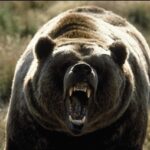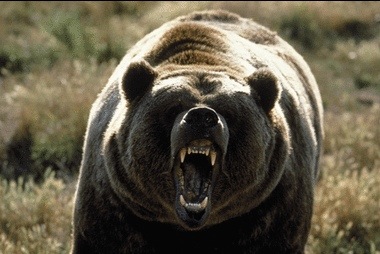
Different Types of Bears
April 2, 2013
Dominating the Bear Woods
April 19, 2013In the next 5 seconds you will be charged by a grizzly bear. That is all you have is 5 seconds to decide your move, your fate. Your next 5 seconds and the decisions you make could change your life, end your life, or just create a good story for you to share year after year like that of Homer’s epic tales.
Have you thought these 5 seconds through? Have you considered the possibility of this becoming a reality? I say 5 seconds because on average that is all you have. 5 seconds is actually giving you time. Most of the studies show that a bear attack from point of encounter to contact is within 3 and 5 seconds, many encounters happen in close quarters often by surprise giving you little or no time. A bear at full charge will moving almost 30mph and can close 40 – 60 yds. In around 3 seconds.
Bears do not have rational thoughts. They do not weigh pro’s and con’s. They do not look at circumstances or consider the repercussions of their actions. They act on instinct! No thought, just survival. That is how you must act in those 5 seconds. No thought just instinct! Survival!
There are 2 types of bear attacks: Predatory and defensive. Most Grizzly bear attacks are defensive in nature and occur because of surprising or startling a bear, getting too close to a bears food source, encountering a sow with cubs, or by breaching a bears comfort zone. Most grizzly bears put in these situations are acting in a defensive mode. They are defending cubs, food, or they feel threatened by your presence in some way. Quite often these encounters result in a bluff charge and the bear exiting the area and leaving you digging through your duffle for a change of pants.
Predatory attacks are pretty simple! You are the prey; if this attack occurs the bear is seeing you as a meal and is targeting you because, to put it simply, wants to eat you! Most bears responsible for these occurrences believe it or not are black bears.
Of the documented cases in the last 110 years (ending in 2009) 88% of fatal encounters between black bears and humans were predatory in nature and of those 92% of the bears were males. To put that in laymen’s terms, if you find yourself on the bad end of a black bear attack you are more than likely being considered a prey item to that animal.
Now that you have some specifics lets work on keeping you safe out in the woods. If you think you are immune or it will never happen you are already dead or maimed! Don’t be so naïve! There were a remarkable 83 grizzly charges in 2011, 66% were in the Greater Yellowstone Ecosystem of those 35% of those charges involved hunters and hikers. There have been 4 grizzly related deaths in 2 years and of those 3 of the people were completely unprepared!
To keep yourself from being a statistic you must first assess the situation. Are you dealing with a predatory bear or a defensive bear? This will then determine you next move.
A predatory bear will exhibit a more silent approach, often times stalking or following you then rushing to contact. You will not see the popping of teeth, woofing and swiping, pawing or running side to side. These bears are very deliberate and focused in their approach. Often times they will not respond to yelling or other aggressive actions like throwing rocks or banging sticks. One death near Yellowstone Park 2 years ago involved a predatory sow grizzly bear that entered 3 tents in a campground eventually killing and partially consuming the 3rd victim. In the first 2 attacks the victims fought and screamed. The bear left both, the 3rd victim was pulled from his tent and found partially consumed. She moved from tent to tent very methodical and deliberate in her approach until eventually getting her prey. Do not every forget that bears are predators and they do not know it is wrong to attack humans.
When encountering a predatory bear it is important to immediately un-holster you gun or bear spray. Do not under any circumstance run! I cannot stress that enough, if you run you lose. Instead slowly back up to a safe distance and try and exit area. If you are near your trailer, vehicle or other hard sided enclosure try and seek safety. If the bear continues to approach prepare yourself for the inevitable. If the bear enters into within 25 yards emit your spray. If the bear attacks you must fight back. This is a completely different attack than a defense attack and fighting back in any way might be your only chance at survival.
A defensive bear will act very different than a predatory bear so your actions will have to be different to ensure you walk away to tell the story! A defensive bear will exhibit some very tell-tell signs that you are in fact on its radar and better be about getting out of the area quickly. Many defensive bears will pop their jaws and teeth creating a clacking sound, “whoof”, run side to side, swipe at dirt, paw the ground and bluff charge. If a bear you encounter participates any of these activities they are feeling threatened by your presence and you must take action to better you position. In this case it is important to remember DO NOT RUN! Run and that bear may see you as vulnerable and give chase. You will not out run a bear, I promise. Instead remain as calm as possible, Un-holster you gun or bear spray and slowly back away talking calmly to the bear. This is a crucial step in staying alive. Don’t immediately hit the ground and don’t climb the first tree. Very rarely do these defensive bear encounters result in an attack and injury. If the bear charges emit your spray in an up and down fashion creating a cloud like wall that the bear cannot avoid. If after the first burst the bear leaves immediately exit the area without running. Stay calm and walk out. If the bear returns you may need to spray again. 2-3 second bursts will be very effective at deterring a charging bear. I would not recommend unloading your whole canister of spray on a bear during the initial encounter as you may need to spray again.
If contact is inevitable in a defensive bear situation try and lay face down with your hands against the back of your neck in an effort to protect your vital areas. Often times you will have a pack on which will help protect your back. Try and use your feet and elbows to keep from being rolled over. If you are rolled over continue rolling until you are on your stomach again. Lay as still as possible, most bears will leave area after they feel a threat has been removed. Do not move until you are sure the bear has left the area or you are certain there is no risk of further attack.
Last year a hiker in Yellowstone lost his life in a grizzly attack. He and his wife encountered a sow and cubs, she showed her aggression and they ran screaming. She gave chase and caught the victim on the trail. She was quick but effective and caused enough damage the man did not live. After the attack on the man she moved over to the wife hiding behind a log on the trail. The wife laid flat on her stomach and plaid dead, the bear tugged at her pack then disappeared. The man likely died from blunt force trauma and a femoral artery injury resulting in blood loss. Hind sight is 20-20, but they did just about everything wrong. Does this mean that if they followed the steps above he would still be alive? Not necessarily, all bears are individuals and act differently. You can do everything right and still have the same result.
Her is a little insight into the speed of the bear. She was initially spotted roughly 100 yards away by the couple. They began running and covered 173 yards before the contact. That sow covered 273 yards. The investigative team conservatively estimated the bear to move 20 mph during this run. This would mean she covered 273 yards in just 28 seconds! The whole incident was said to last only around 1 minute.
These are simply guidelines to help ensure you have all the tools available to give you the best chance for survival in a bear encounter.
I so often hear hunters say “bear comes at me I’ll just shoot them”, or “I have been in the hills my whole life, I can handle it”. Hunters can be arrogant in their abilities to survive in bear country, this can create some indifference and quite often they will enter the backcountry unprepared. In my opinion proper planning predicts the future. You do not have to go out in the back yard and rehearse these situations with your wife or kid playing bear. I do however encourage you to always be thinking an encounter can happen and replay the events of an encounter in your head. Rehearse these in your mind until every scenario plays out and your reaction becomes second nature. This will ensure that if you are face to face with a bear your reaction will be like the bears, Instinctive. Also, be sure the people you hunt with have the knowledge of the proper procedures to keep themselves safe.
Grizzly bears are expanding their home range and are being found in areas they haven’t been seen since the settlers came west. If you hunt out west in the Rockies or Cascades, or in Western Canada there is a good chance you can encounter a grizzly bear. You are naïve if you think you are immune, It is your obligation as a sportsman to ensure you are prepared for this. One friend told me on my first hunt in the grizzly country near Cody, WY years ago. “Don’t be afraid, be aware”. I’m not trying to scare you, just put into your mind that you have to be aware of situations like this. I have hunt, camp and live in grizzly country; I hunt bears over bait and by spot and stalk. I enjoy every chance I can to spend time around bears and learn what I can about them through observing their behavior. I always try and remind myself that I cannot get complacent. I have encountered aggressive bears, and thankfully nothing bad has come of it. I say all this because most often guys who hunt bears, especially over bait get hardened by being around bears so much. They often forget about the dangers of our sport. The next time you step in the bear woods just remember you are in their home, be ready for anything.
Written by BoarMasters Prostaffer
Joe Kondelis with
Yellowstone Country Bear Hunters Asscociation. http://site.ycbearhunters.org/


